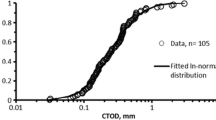Abstract
It has become very clear that in many cases fracture toughness for a given material is variable; for example a quenched and tempered, high-strength low-alloyed steel such as might be used for the construction of pressure vessels for nuclear-power plants or off-shore platforms. Indeed for these materials fracture toughness can no longer be looked upon as a single-valued property at any given temperature but must rather be seen as a property with an inherent distribution of its values. The present paper shows that recent models for the distribution of toughness which are based on the two-parameter Weibull function are potentially dangerously non-conservative both for the estimation of low and medium values of toughness and for the estimation of the sizes of defects present in proof-tested parts.
Résumé
Il est devenu très clair que, dans de nombreux cas, la ténacité à la rupture d'un matériau est variable. Ainsi en est-il d'un acier à haute résistante faiblement allié, trempé et revenu, de la nuance utilisée pour la fabrication des capacités sous pression des centrales nucléaires, ou des composants de plateforme offshore.
Pour ces matériaux, en effet, la ténacité à la rupture ne peut plus guère être considérée comme une propriété à valeur unique pour une température déterminée, mais doit plutôt être envisagée comme une propriété dont les valeurs répondent à une distribution qui lui est caractéristique.
Le mémoire montre que les modèles récemment proposés pour décrire la distribution de la ténacité, qui sont basés sur une fonction de Weibull à deux paramètres, sont potentiellement empreints d'une dangereuse insécurité, pour l'estimation des valeurs inférieures et moyennes de la ténacité et pour l'estimation de la dimension des défauts présents dans les pièces soumises à essais.
Similar content being viewed by others
References
A. Pineau, in Proceedings 5th International Conference on Fracture, vol. 2, Cannes, France (1981) 553.
K. Wallin, Engineering Fracture Mechanics 19 (1984) 1085.
T. Iwadate,et al., ASTM STP 803, vol. 2 (1983) 531.
D.J. Neville and J.F. Knott, Journal of Mechanics and Physics of Solids 34 (1986) 278.
D.J. Neville, Ph.D. thesis, University of Cambridge (1985).
D.J. Neville, Proceedings of the Royal Society A410 (1987) 421.
D.J. Neville, Engineering Fracture Mechanics 27 (1987) 143.
S. Slatcher, Fatigue and Fracture of Engineering Materials and Structures 9 (1986) 275.
S. Slatcher, Proceedings 6th European Conference on Fracture (1986).
D.J. Neville and J.F. Knott, Journal of Mechanics and Physics of Solids 34 (1986) 256.
D.J. Neville and J.F. Knott, Journal of Mechanics and Physics of Solids 34 (1986) 243.
D.J. Neville, in preparation.
Author information
Authors and Affiliations
Rights and permissions
About this article
Cite this article
Neville, D.J. The non-conservatism of the Weibull function when applied to the statistics of fracture toughness. Int J Fract 34, 309–315 (1987). https://doi.org/10.1007/BF00013085
Received:
Accepted:
Issue Date:
DOI: https://doi.org/10.1007/BF00013085



